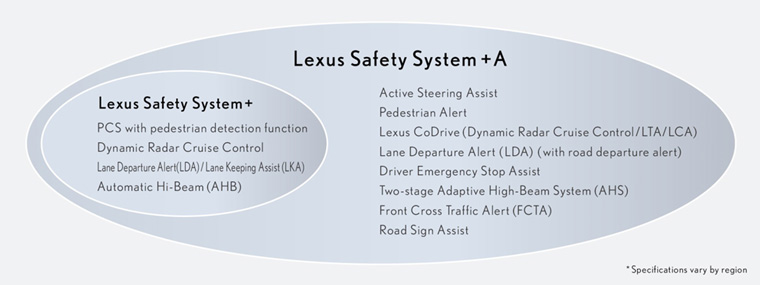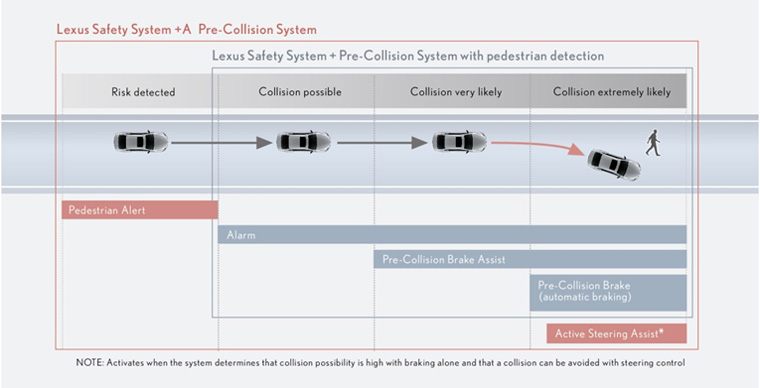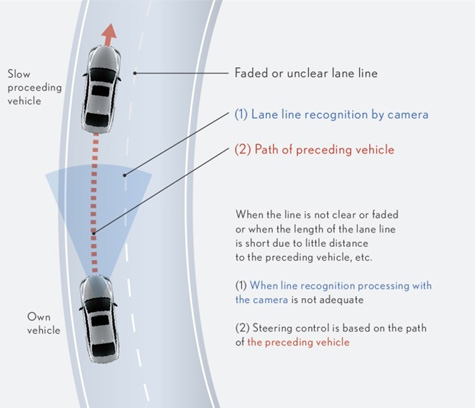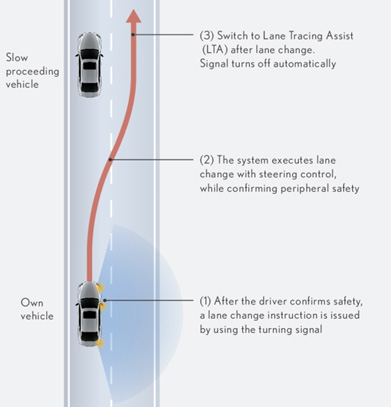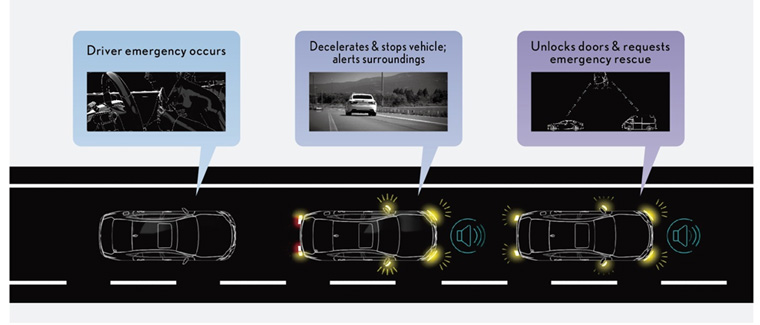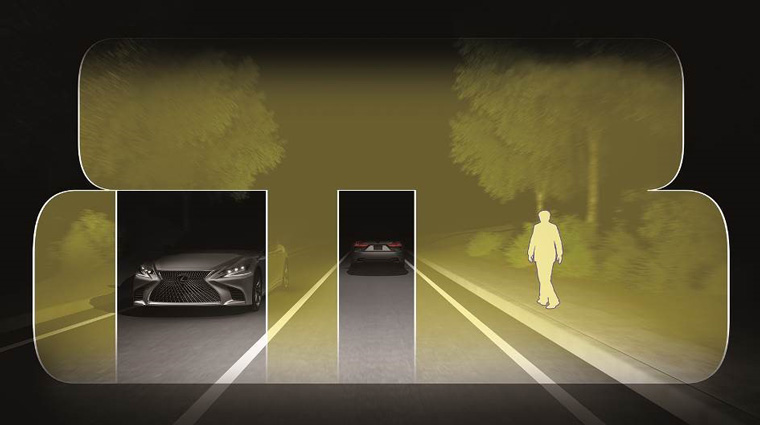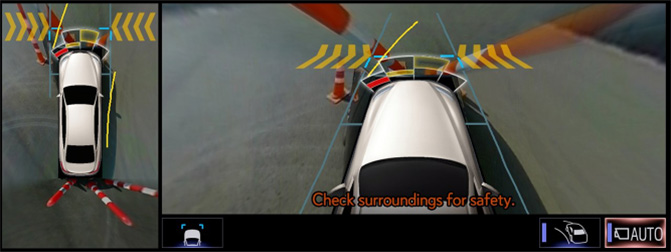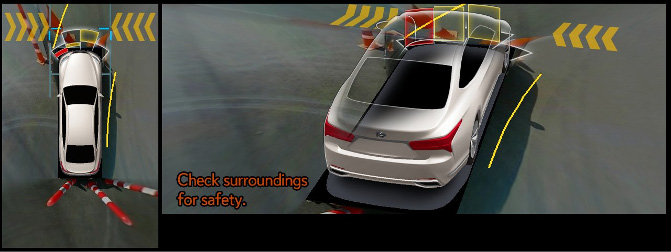Jun. 26, 2017
Lexus Outlines Advanced Active Safety Technologies for All-new 'LS'
Fully Redesigned Flagship Combines Safety Systems toward Elimination of Traffic Casualties
Toyota City, Japan, June 26, 2017―The all-new Lexus "LS" sedan scheduled for sales launch this autumn aims to provide world-leading safety performance through the combination of two advanced Lexus safety systems―Lexus Safety System + and Lexus Safety System + A. Lexus today outlined the features of these systems, which are ultimately aimed at the elimination of traffic casualties.
While the fifth-generation of the Lexus LS*1 carries on the tradition of a smooth and powerful ride and exceptional quietness and comfort that started with the launch of the first generation as a new standard for luxury cars, its GA-L platform gives it driving that is both elegant and profound, offering the driver the thrill of as-you-command control. As a symbol of Lexus, the fully redesigned LS achieves a bold transformation through the adoption of new styling and advanced technologies within an innovative coupe-like silhouette, while affording ample interior spaciousness befitting a luxury sedan.
As a flagship that pioneers a new age, the LS boasts extensive application of advanced safety technologies. Specifically, the already well-established active safety package Lexus Safety System +, which is based on the Integrated Safety Management Concept*2, has been combined with Lexus Safety System + A, which provides advanced pre-collision support and sophisticated driving assistance, in Japan, North America and Europe. The LS will also come with other technologies for supporting safer and more-secure driving in a broad range of situations. Support has been designed to be clear and intuitive, such as by providing the driver with information ranging from support status notifications to information on vehicle behavior during safety feature operation via a large head-up display (HUD) and a multi-information display.
Added to improvements in the various features of Lexus Safety System +, which packages the Pre-Collision System (PCS), Lane Departure Alert (LDA) and Dynamic Radar Cruise Control, is Active Steering Assist, which, as a world-first technology*3, helps prevent collisions that cannot be avoided through automatic braking alone, and Front Cross Traffic Alert (FCTA), which is designed to warn the driver of the possibility of head-on collisions at intersections. These features, along with Lexus CoDrive, which assists the driver in maintaining in-lane driving or in changing lanes, and others achieve a high level of driving safety support.
In addition to conventional PCS, which supports collision prevention and damage reduction through alerts, Pre-collision Brake Assist and Pre-collision Braking, the new LS is equipped with Pedestrian Alert, a world-first technology*3 that specifies the direction of the presence of a pedestrian, and Active Steering Assist, which can automatically controls steering and braking. With Pedestrian Alert, if there is the possibility of collision with a pedestrian ahead, the direction of the pedestrian's presence is shown in an animation via the LS's large color HUD, contributing to intuitive recognition on the part of the driver. Active Steering Assist determines when there is a high possibility of collision with a pedestrian in the lane of travel or with a continuous structure, such as a guardrail, and if the system also determines that it is difficult to avoid a collision with brake control alone but that it might be avoided with steering control, the system assists in collision prevention or damage reduction through automatic steering control in addition to activating an alert and applying the brakes.
Lexus CoDrive adds Lane Change Assist (LCA) to the basic functions of Dynamic Radar Cruise Control and Lane Tracing Assist (LTA) to provide steering support that is in line with the intentions of the driver and lane-changing support on highways or motor-vehicle-only roadways. By providing seamless driving support on roads with many curves or in traffic jams, Lexus CoDrive largely decreases driver burden. It coordinates with the LS's large HUD and multi-information display to clearly notify the driver of the state of support provided.
Lane Tracing Assist provides lane-keeping support by way of steering control when Adaptive Cruise Control is in operation. In addition to lane line detection by way of a camera, tracing of the path of the vehicle ahead enables assistance even when lane lines cannot be recognized, such as in low-speed driving in congestion when there is little distance to the preceding vehicle. If the speed of entering a curve is found, based on navigation data, to be too fast, the driver is alerted by way of the LS's HUD and multi-information display, and the vehicle is automatically slowed down.
LCA, which uses driver manipulation of the turning signal as a cue to activate, supports lane changes by monitoring the surrounding road environment and, at the appropriate timing, controls steering, as well as acceleration and deceleration.
If non-operation by the driver continues during use of LTA on a motor-vehicle-only roadway, Driver Emergency Stop Assist supports the driver through audio and visual alerts and gentle deceleration. It then activates the vehicle's hazard lamps and horn to alert those outside the vehicle to help prevent or reduce damages to the vehicle or to others, while slowing and eventually stopping the vehicle within its lane. After stopping, it unlocks doors and activates an automatic HELPNET connection for a rescue request, contributing to early driver rescue.
With eight LED lights at the top and 16 below (on each side), the Two-stage Adaptive High-beam System provides optimal lighting by way of separate on/off control of each row of LEDs, enabling finer control of light strength and distance compared to the existing LED-based AHS. This allows higher frequency of high-beam driving without blinding preceding or oncoming vehicles, thus improving nighttime visibility.
To help prevent collisions at intersections, FCTA is meant to detect forward cross-traffic vehicles. It uses forward direction radar and is the first in the world*3 to alert drivers of the direction from which a cross-traffic vehicle is approaching the immediate intersection. Alerts are displayed using the LS's large HUD. If the vehicle proceeds regardless of the presence of an approaching vehicle in cross traffic, warnings are also issued by a buzzer and the LS's multi-information display.
RSA acquires road sign information using a camera and navigation maps and then displays such using the LS's HUD and multi-information display, thus reducing driver failure to recognize signs and encouraging safe driving.
Lexus has further evolved the performance of PCS, LDA and Dynamic Radar Cruise Control in the active safety Lexus Safety System +, which has been featured in a growing number of vehicle models and has been combined with Lexus Safety System + A in the LS.
PCS detects pedestrians and vehicles ahead using millimeter-wave radar and a stereo camera and supports collision prevention and damage mitigation with an alert, Pre-collision Brake Assist and Pre-collision Braking. The improved PCS can detect bicyclists and nighttime pedestrians and has improved deceleration performance during automatic braking. For example, it can decelerate the vehicle by as much as 60 km/hour when a pedestrian is detected, thus improving its collision-prevention performance.
LDA helps to prevent lane departures. In addition to detecting road lane lines, it is now also capable of detecting the boundaries between asphalt and such elements as grass, dirt and curbstone through advances in recognition capability. Thus, it can now perform its functions of alerting the driver and operating the steering wheel even on roads that do not have lines.
Outstanding basic recognition performance has been secured with wide-angle detection using newly developed millimeter-wave radar and a camera with a wider forward recognition range. Dynamic Radar Cruise Control also provides support for making driving more comfortable, with smooth acceleration at startup, and during following, departure and acceleration, for a sense of security for occupants, and smooth deceleration in the case of a rapid change in deceleration speed during following.
With the aim of reducing damage from accidents when parking, during which moving vehicles and pedestrians, in addition to walls and other stationary objects, perimeter checks and complicated driving operations are considerations, low-speed braking support systems have been integrated into a single package. Added to the already commercialized Intelligent Clearance Sonar (ICS) and Rear Cross Traffic Auto Brake (RCTAB) is the world's first*3 rear pedestrian support brake, which detects pedestrians using a rear camera, and in the case of a possible collision, helps to minimizes damages by using alerts and brake control.
Side clearance view and cornering view functions have been added to the Panoramic View Monitor, which supports periphery safety checks. Side clearance view produces an image on the LS's 12.3-inch display monitor of the area in front of the car as if it were seen from an elevated point at the rear of the car, allowing the driver to more-intuitively confirm the space on the sides of the vehicle when passing by another vehicle on a narrow road or when moving toward the shoulder of the road to allow passage. When side clearance view is in operation, cornering view automatically produces an image of the vehicle as viewed from the rear at an angle in line with driving operation during cornering. These assist in confirming safety when making left or right turns on narrow roads and in preventing the driving up onto curbstones when departing the roadway.
The Digital Rear-View Mirror, which shows the image captured by a rear camera on a built-in display in the rear-view mirror, was developed as a driving support device. In addition to making rear safety checks possible by producing an image without objects that obstruct the view, such as the heads of rear-seat passengers, etc., it contributes to enhancing visibility at night and in rainy weather, as well as when the rear-window sunshade is in use, and to protecting the privacy of rear-seat passengers.
Also, operation of a lever switches the display between optical mirror mode and digital mirror mode.
*1Introduced to the Japanese market in its fourth generation (in 2006)
*2An approach that, rather than considering a vehicle's individual safety technologies and systems independently, aims for coordination in the pursuit of an even higher dimension of driver support in all driving situations
*3As known as of June 2017 (based on a Lexus survey)
*4System operation depends on the driving environment (including road and weather) and vehicle circumstances; specifications vary by regions.





